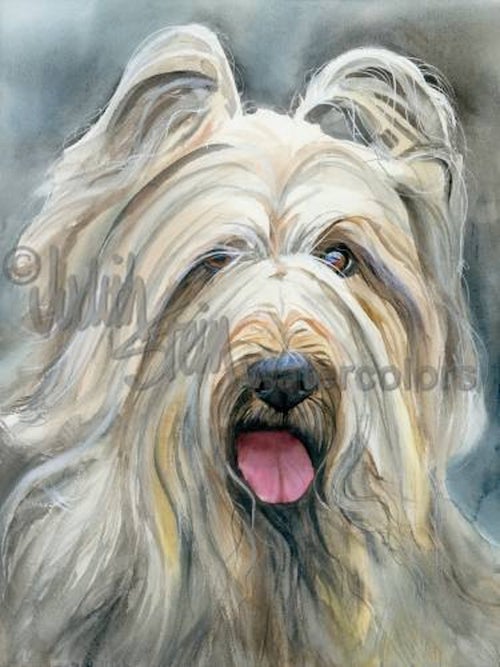
Old breed standards can be hard to find, but they are often worth the search because they offer insights into a breed’s early history, and specifically, what was acceptable or not at the time.
The Club du Chien de Berger (Shepherd Dog Club) formed in 1896, and in 1897 it drew up the first standard for the Briard. A more precise standard for the breed was drawn up in 1925 by the Les Amis du Briard (Friends of the Briard) society, and in it was a disqualification for “oeil vairon,” which translated means “spotted eye” or “wall eyes.” “Minnow eyes” are also mentioned in other descriptions we’ve seen of Briard eyes, and one wonders what any of them mean. We got our first hint when we searched for “minnow eyes” and found reference to it in the Beauceron in which minnow eyes are allowed in the harlequin variety.
When we added “wall eyes,” to the search, we found that eyes that are a pale bluish-white iris with flecks of brown are seen in some Harlequin Great Danes. A paper written in 1953 by Arnold Sorsby and J. B. Davey on the subject of merling and dappling mentions that a wall eye is a blue/pale colored eye.
It was a roundabout way to determine, then, that light blue eyes, or eyes in which the iris lacks pigment and is ringed with white were a disqualification in the Briard back in 1925, and as of 2020, yellow eyes or spotted eyes are still a disqualification, the AKC standard calling for eyes that are “black or black-brown with very dark pigmentation of the rim of the eyelids.”
Interestingly, history suggests that the Briard and Beauceron were once considered the same breed. It wasn’t until 1809 that an official difference between the two was understood and written about by Abbe Rozier who called the dogs Berger de la Brie (for the Briard) and Berger de la Beauce (for the Beauceron). In 1863, Pierre Megnin described the different qualities of each breed, the Briard having a longer coat than the Beauceron. It’s probable, then, that the authors of the 1925 Briard standard fully intended that when they made the “spotted eye” a disqualification, it served to further distinguish between Beaucerons and Briards since one was a breed in which minnow eyes were allowed, and the other in which it was a disqualification altogether, respectively.
Image: Briard by Judith Stein/
www.judithstein.com
https://www.etsy.com/shop/k9stein
